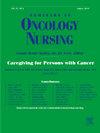英国肿瘤学护士样本中与危险药物安全处理预防措施相关的预测因素及对新疗法的影响。
IF 2.3
4区 医学
Q1 NURSING
引用次数: 0
摘要
目的:新型全身抗癌疗法(SACT)的开发和应用正在迅速发展。虽然细胞毒性药物传统上是治疗的基石,但它们越来越多地与新型药物一起使用。本研究旨在评估影响安全处理预防措施依从性的因素,加强安全协议,并最大限度地减少临床环境中潜在的职业暴露,提高他们的新治疗能力。方法:对全英国处理SACT的肿瘤科护士进行横断面在线调查。参与者被要求填写危险药品安全处理预防措施使用预测因素问卷。进行描述性分析、Spearman秩相关系数和回归分析,以确定处理hd时预防性使用的预测因素。研究结果:对(n = 675)名参与者的分析显示,他们对工作场所的暴露有较高的认识、较高的自我效能、较低的感知障碍、中等的感知风险、较高的人际影响、较低的利益冲突和中等的安全气候。年龄与知识(rs = 0.093)、自我效能感(rs = 0.103)、安全处理得分(rs = 0.082)呈弱正相关;参与者的年龄与感知障碍(rs = -0.141)、利益冲突(rs = -0.116)和工作场所安全气候(rs = -0.116)呈弱负相关。值得注意的是,安全处理得分与其他理论预测指标没有显著相关性。比较政府部门和私营部门护士(n = 76)的患者数量F (15.807, 74), P < 0.001,政府部门护士的安全处理得分F(4.135, 74)显著低于私营部门护士(P < 0.05)。结论:政府和私营部门设置的护士-患者比例预测全球安全处理预防措施。对实践的影响:新的治疗方法对护患比例至关重要,因为新的治疗方法和时间表进一步造成额外的工作量压力,可能会减少安全处理实践。本文章由计算机程序翻译,如有差异,请以英文原文为准。
Predictor Factors Associated With Hazardous Drug Safe Handling Precautions Across a UK Oncology Nurse Sample and Implications for Novel Treatments
Objectives
The development and use of novel systemic anticancer therapy (SACT) treatments are advancing rapidly. While cytotoxic drugs have traditionally been the cornerstone of treatment, they are increasingly used alongside novel agents. This study aims to assess factors affecting adherence to safe-handling precautions, enhance safety protocols, and minimize potential occupational exposure to hazards in clinical environments, increasing their capacity for novel treatments.
Methods
Cross-sectional, online survey of oncology nurses across the UK who handled SACT. Participants were asked to complete the Factors Predicting Use of Hazardous Drug Safe-Handling Precautions Questionnaire. Descriptive analysis, Spearman rank correlation coefficients, and regression analysis were performed to determine the predictors of precautionary use when handling HDs.
Findings
Analysis of (n = 675) participants revealed high knowledge of exposure, high self-efficacy, low perceived barriers, moderate perceived risks, high interpersonal influence, low conflict of interest and moderate safety climate in the workplace. The analysis of the data also indicated weak positive correlations between age and knowledge (rs = 0.093), self-efficacy (rs = 0.103) and safe-handling scores (rs = 0.082); the age of the participants has a weak negative correlation to perceived barriers (rs = –0.141), conflict of interest (rs = –0.116), and workplace safety climate(rs = –0.116). Notably, safe handling scores showed no significant correlation with other theoretical predictors. Comparison between government and private sector nurses (n = 76) demonstrated higher patient volumes F (15.807, 74), P < .001 and significantly lower safe handling scores in the government settings F (4.135, 74) P < .05.
Conclusions
Nurse-patient ratios between government and private sector settings predict global safe-handling precautions.
Implications for practice
Novel treatments for nurse-patient ratios are essential, as new therapies and schedules further create additional workload pressures that may reduce safe handling practices.
求助全文
通过发布文献求助,成功后即可免费获取论文全文。
去求助
来源期刊

Seminars in Oncology Nursing
Nursing-Oncology (nursing)
CiteScore
3.40
自引率
0.00%
发文量
68
审稿时长
45 days
期刊介绍:
Seminars in Oncology Nursing is a unique international journal published six times a year. Each issue offers a multi-faceted overview of a single cancer topic from a selection of expert review articles and disseminates oncology nursing research relevant to patient care, nursing education, management, and policy development.
 求助内容:
求助内容: 应助结果提醒方式:
应助结果提醒方式:


